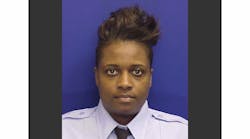Multitude of Errors Uncovered in Philly LODD Probe
Source The Philadelphia Inquirer
A Philadelphia Fire Department investigation found delayed responses, tactical errors, and communication failures at the scene of the December blaze that killed Firefighter Joyce Craig, according to internal documents obtained by The Inquirer.
The report reinforces accounts from firefighters that indicate critical time passed before commanders realized that Craig was unaccounted for and in grave danger.
As other firefighters have said, Craig was pulled from the house 17 minutes after her first Mayday alarm sounded, when firefighters found her by chance.
"The circumstances surrounding this incident have identified real training deficiencies within the Philadelphia Fire Department," Deputy Fire Chief Richard Davison, who was assigned by the department to review the fire, wrote in the critique.
He added that such deficiencies are not new for the department.
The report found that too often, the training firefighters receive ends once they leave the academy, and those basic skills are not reinforced until after "a negative outcome" like Craig's death on Dec. 9 in a West Oak Lane basement fire. It stressed the need for a "renewed emphasis on training and basic firefighting skills and procedures."
In the report, Davison does not name any individual officers or firefighters besides Craig. He does not recommend any punishment, saying the report is not about "assigning blame."
Firefighters union president Joe Schulle said that while he was encouraged by the report's recommendations for further training - something that the union has been requesting for years - he felt the report lacks the detail necessary to provide a thorough accounting of the fire.
"It didn't give a sense of what it was like on the fire ground that night," he said. "It's talking very broad terms. All the questions remain unanswered."
Those questions, he said, include how the fire grew out of control, how Craig was lost, when it became known she was missing, and how long it took to muster a concerted effort to retrieve her.
It is unclear when Davison's report was completed, or if the department had planned to release it publicly. Fire Commissioner Derrick Sawyer did not respond to requests for comment Monday.
Officials have yet to publicly provide an explanation of Craig's death, and have repeatedly declined to give details on their investigation, which they say is continuing. The National Institute for Occupational Safety and Health, the Philadelphia Fire Marshal's Office, and the Medical Examiner's Office are also investigating the deadly fire.
Craig was the first female firefighter to die in the line of duty. She was working an overtime shift with Engine 73 - not her usual posting - when the alarm rang for a fire on the 1600 block of Middleton Street. She was one of the first inside the house as part of a three-member attack team working a hose line.
At first, the firefighters saw only light smoke, but then a basement door was opened and flames shot up.
In an interview last week, Craig's coworker Nyree Bright described a chaotic and confusing fire scene in which Craig's Mayday alarm went unheeded, and those who could have rescued her were not told she was missing.
The findings of the report similarly indicate confusion on Middleton Street. After the fire suddenly shot up from the basement into the upper floors, the incident commander told Davison that assignments for his firefighters had to be improvised.
The report also noted some confusion inside the house - there were problems with the deployment of the hose, the basement door was not shut when it should have been, and there was poor communication with the incident commander outside.
In the interview, Bright said she left the house after her mask malfunctioned. Her lieutenant, disoriented by the sudden smoke and flames, also left. Craig was still inside.
And although her Mayday alert was sounding, Bright and other sources have said, no one sent in a rescue team.
The report was vague about who knew Craig was missing and when. But it stresses the need for a new system for keeping track of firefighters.
"It has been repeatedly documented that not knowing who is actively operating on the fire ground, what they are doing, and where they are doing it is contributing to firefighter deaths," Davison wrote. That, he wrote, is the primary responsibility of the incident commander.
The incident commander told Davison that there was difficulty coordinating both rescue efforts and "fire suppression operations."
The second-in-command, who was directing firefighters on the other side of the house, said he did not know where Craig was or whether she had been rescued, and added there was a "lack of fire-ground communications."
The next company sent in after Craig's told Davison they had been ordered to fight the fire and search for Engine 73's dropped hose.
Department sources have told The Inquirer that these firefighters and other responding companies were not informed Craig was missing.
The report said the department needs to retrain its battalion chiefs and officers in how to respond to a Mayday call.
"Mayday training is a matter of life or death," Davison wrote. "Once a Mayday is transmitted, the officer must be aware of the many things that must take place."
According to the report and department sources, problems with the Middleton Street fire began as it was dispatched.
A nearby ladder company responding to a medical call asked to be detoured to the fire and a dispatcher said no, sources said. And the ladder company assigned to replace it got lost on its way to Middleton Street, taking 17 minutes to arrive.
Ladder companies are charged with rescue operations and ventilation, which is crucial to clear homes of smoke and help engine companies putting water on the fire navigate the building.
The ladder companies' delays meant that not enough firefighters were available to properly ventilate the house, leading to quickly worsening fire conditions and preventing a coordinated rescue effort.
Davison wrote that such tactical confusion spoke to larger problems in the department.
"We seem to have lost focus that coordinated operations of ventilation and extinguishment are the key components to a successful fire-ground operation," he wrote. He added that the department's approach to ventilation is outdated and recommended retraining.
In addition, he said, all firefighters need to receive regular training on how to fight basement fires - and, beyond that, "back-to-basics training."
He wrote that he hopes the department's "upper management" will act quickly upon the "lessons learned."
"The lessons are not new," he said, "but are serious enough to highlight to prevent similar future tragedies."
215-854-2961
@aubreyjwhelan
———
©2015 The Philadelphia Inquirer
Visit The Philadelphia Inquirer at www.philly.com
Distributed by Tribune Content Agency, LLC







